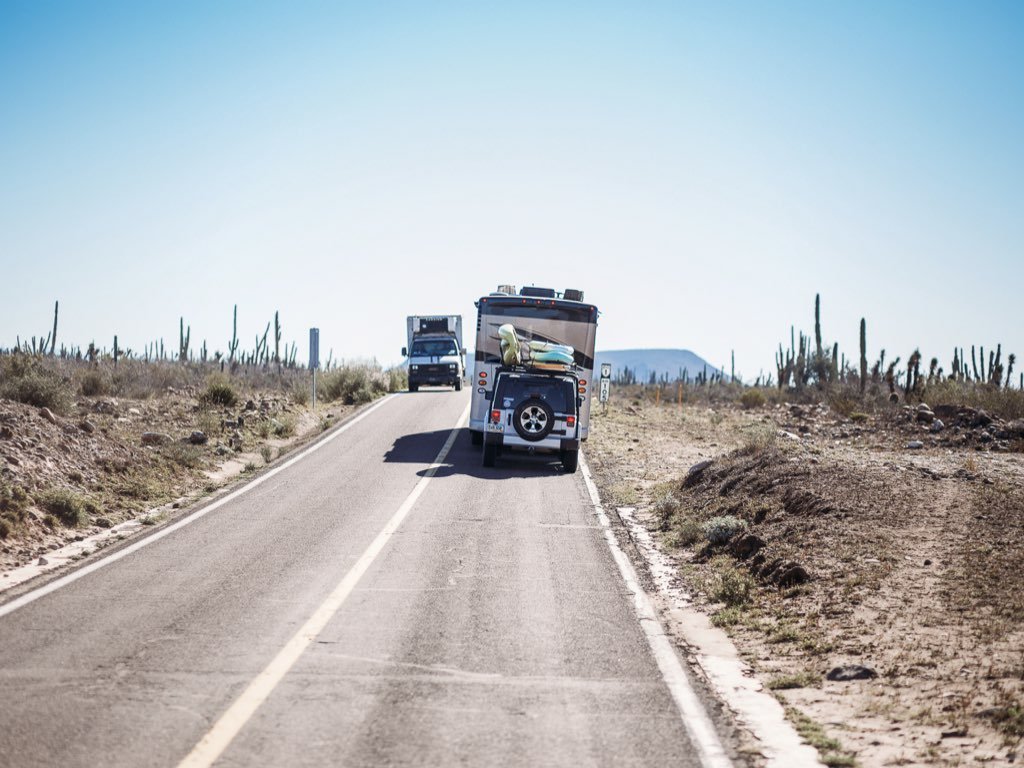Tips For Driving In Baja, Mexico
Driving in Baja is very different than driving in the United States in SO many ways. After trekking down the entire Baja Peninsula 3 years in a row, we can share what to expect, along with some tricks and tips we’ve picked up along the way! For reference, we drive a Ford F350 and tow a 42 ft. fifth wheel and have caravanned with other large rigs including large Class A’s, but we all brave the Baja roads and make it just fine (minus one rear view mirror. Keep reading!)
Drive Day Tips
1 . Don’t drive at night. Once you get out to the outskirts of town or into the country, cows, burrows and other animals are easy to hit in the road at night. They will sometimes be in the road during the day too, but you can see them at least! Driving in towns at night was fine, but I still preferred to not drive at night in cities due to strange traffic patterns that are hard to navigate at night.
2. Fill up with fuel often, and plan out your gas station stops during drive days. Gas stations are known to run out of gas, especially during big events like Semana Santa (Easter Week) and the Baja 1000 race. In small towns, they may only have one gas station that has diesel, with the next gas station over an hour away. Make sure you always have enough fuel to get to that next gas station. In our experience, we never have had a problem finding diesel. But we still rarely let the tank reach 1/2 empty just in case.
3 . Carry extra fuel tanks with you as a precaution. You can’t cross the boarder with extra fuel, so fill them up after you cross the border. Enough gas for an extra 50-100 miles gives a LOT of peace of mind.
4. Always carry Fix a Flat and a spare tire. There are Llantera shops all over the peninsula. These are tire shops where you can get repairs or new tires when needed, so getting a new tire isn’t the hard part. But there are long stretches of highway with absolutely nothing, so getting to the Llantera can be the problem.
5. Don’t be afraid to slow down on the highways. There are many stretches on highway that are extremely narrow, especially when you are driving a big RV! This can cause major problems when a huge big rig truck is coming at you at 50+mph. Instead of losing a rear view mirror or falling off the side of the road (there are some big drops in many places!), we start slowing down to 15-20 mph (and even come to a complete stop when needed!) when we see a large semi coming toward us. Take your time, don’t worry about traffic behind you, and get to your next destination safely. Some years depending on the storms that came through in prior months, potholes can be bad so you always have to stay on high alert.
Big City Driving Tips
The following tips are mostly for the city of La Paz, which is the biggest city in Baja. Although they are very friendly in their interactions with tourists, cops are known to target gringos for tickets.
1 . Even touching your cell phone while driving is a ticketable offense. Trust us, we got one! It doesn’t matter if you’re simply checking your GPS while waiting at a red light, they can and will ticket you.
2. Complete stops at stop signs. Stop signs are mostly a suggestion to most locals, but make sure you come to a complete stop and even pause for a second before going. Sometimes there are two stop signs within 20 feet of each other for no logical reason. It doesn’t matter. Complete stops at each one.
3. Do not turn right on a red light. You may get honks from locals behind you, but hold your ground unless you want to chance a ticket.
4. Do not drive under a yellow light. Treat it as a red light and stop.
4. Buy a dash camera with microphone. It can help in your interactions with the police if they know you have one and you can even bring it to court if you need to contest a ticket.
5. If you get pulled over… Be kind and courteous to the policia, stand your ground if you didn’t do anything wrong, and never pay them directly. We got pulled over for running a YELLOW light. The cop, in decent english, tried to tell me I should have stopped and let people cross the cross walk. After 10 minutes of conversation, multiple instructions to follow him to the police station to pay my ticket (I said I would follow him there, but he never took me there), and a lot of long awkward pauses, he gave me a fist bump and said, “you can go amigo”. He never asked for money but he tried to create a situation where it would have been much easier for me to pay him instead of following him to the police station.
If you get a ticket. If you get a ticket, it is a pretty simple process to get your license back (they take it from you to ensure to go pay your ticket. Make sure you ask exactly what location to go to. Once you arrive, you may see a judge or you may just pay your fine and the office. If needed, you can ask for an interpreter for things like:
Arguing your ticket (If you feel you were innocent).
Asking questions about what you did wrong.
Asking questions about local traffic laws.
The Baja driving fact sheet
You must have Mexican insurance when driving in Baja! We recommend Lewis and Lewis.
Speed limits are posted in kilometers, not MPH.
Roads are NARROW, so drive slowly when oncoming traffic is coming (especially semi trucks). After our friends’ Class A mirror collided with a Semi truck’s side mirror and smashed to pieces, we started slowing down to around 15MPH when passing big rigs.
Speed limits seem to only apply to tourists, so just because you see locals speeding past you, don’t assume you can too!
Stop signs (ALTO) are small and may be hidden at times by trees and parked vehicles. They are often placed in odd spots, and often very close together, so always be on the lookout when in towns.
There are military checkpoints throughout Baja. Sometimes you can be charged 5-20 pesos for random things (like spraying the undercarriage of your vehicle for insects). There is no way to verify the validity of the charges, so just be prepared to pay. On a good day, you’ll breeze through the checkpoints, but sometimes they will decide to do a thorough search of your vehicle(s). We never had any issues with the guards, but it’s always a good idea to keep a close eye on them as they walk through your vehicle.
The military checkpoint near San Ignacio has been known for bad behavior, so we recommend hiding money and valuables and walking through with the officer, filming with your phone to keep them honest. Sometimes they will say that is not allowed because it is a military checkpoint, so it’s best to listen, but you can always try explaining that you’re filming for your insurance company or your kids are doing it for school if you feel a need to explain yourself.
It’s important to remember that they don’ t have any authority or right to take your items (as long as they’re legal.) They will sometimes grab binoculars or flashlights (some of their favorite items to confiscate) and say, “I take?” or “Para mi?” A firm “NO” should deter them, but there have been reports of people having to physically take the items away from them. They are armed soldiers, so this can be intimidating, but from everything we’ve heard, standing your ground and not allowing them to take your stuff is important.
Overall, driving through Baja was not as big a deal as we had thought!
Driving slowly on the highways when large oncoming vehicles are passing is arguably the most important tip to ensure a safe trip. Other than when driving in La Paz, every other town’s police didn’t bother us at all. We have heard that border town policia can target foreigners as well.
A scary, unfortunate situation that happened to a friend of ours is something we are putting here not because we think this happens often or is likely to happen to you, but just so you know it has happened and know how to respond if it were to happen to you.
Stuart had a very disturbing encounter with the police in La Paz. He was by himself in his truck, and was pulled over. The cop said he had done something wrong, which he hadn’t. He told him he did nothing wrong and the cop got on the phone and called some of his police buddies. They all walked up to his window and told him to get out. (it’s important to know you should NEVER get out of the vehicle for a traffic infraction. It isn’t policy and you never have to get out of your vehicle.)
One cop went in the truck and removed his SD card from the dash cam, pocketed it, and another cop threw him down and took his wallet, removed the money inside and threw it back down, and they were off. The corruption within the police in Mexico is a real problem. However some people have been coming to Baja for years and have never had an encounter with them. You just never know!










